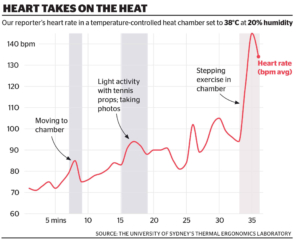HEAT AND HUMIDITY, THE ELITE ATHLETES’ UNSEEN ADVERSARIES
Heat and humidity have a significant impact on elite athletes, particularly tennis players at tournaments like the Australian Open. Key points include:
1. **Heat as an Invisible Adversary**: Elite tennis players, despite their fitness, are highly susceptible to the challenges posed by heat, especially in tournaments like the Australian Open and US Open. These conditions test their endurance and physical limits.
2. **Impact on the Human Body**: Exposure to high temperatures and solar radiation increases skin temperature and core body temperature. This leads to increased heart rates and a feeling of intense heat, even without physical exertion.

3. **Body’s Response Mechanisms**: The human body attempts to regulate its temperature through increased blood flow and sweating. In high temperatures, blood flow to the skin can increase significantly to dissipate heat, and sweat evaporation becomes a critical cooling mechanism.
4. **Challenges of Humidity**: High humidity can severely reduce the body’s ability to cool itself through sweat evaporation, leading to increased risks of overheating and heatstroke.
5. **Effects on Athletic Performance**: Heat stress can lead to reductions in athletic performance, including decreased endurance, slower running speeds, reduced VO2 max (maximum oxygen consumption), and increased muscle fatigue.
6. **Dehydration and Performance**: Heat and sweating can lead to dehydration, which further impairs performance by reducing blood volume and oxygen delivery to muscles.
7. **Rising Temperatures at the Australian Open**: There is evidence that temperatures have been rising at the Australian Open over the years, leading to more days of extreme heat and challenging conditions for players.
8. **Heat Management Policies**: The Australian Open employs a heat management policy that includes monitoring environmental factors and potentially halting play under extreme conditions.
9. **Heat Acclimation Training**: Athletes increasingly use heat acclimation training to adapt their bodies to high temperatures, improving their cooling mechanisms and overall performance in hot conditions.
10. **Sweat Testing for Personalized Hydration**: Some players undergo sweat testing to determine individual sweat rates and compositions, allowing them to create personalized hydration strategies to combat the effects of intense sweating.
11. **Risk of Overheating During Competition**: Even though players might be aware of their body’s struggle in the heat, the competitive nature of the sport can push them beyond safe limits, necessitating official intervention through heat policies.
Source: SMH 21Jan24



